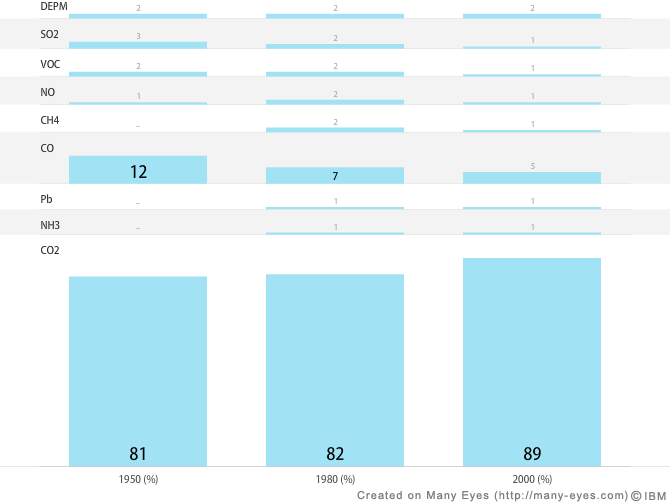Teaching:TUW - UE InfoVis WS 2008/09 - Gruppe 10 - Aufgabe 3: Difference between revisions
(Added Evaluation) |
(Revised part of Evaluation) |
||
| Line 7: | Line 7: | ||
== Evaluation == | == Evaluation == | ||
As it is written at the top of the graph the primary aim is to show that: | |||
* pollution grows (through the size of the cube) | * pollution grows (through the size of the cube) | ||
* immediately-hazardous pollution decreases (through the bars in the cube) | * immediately-hazardous pollution decreases (through the bars in the cube) | ||
* CO<sub>2</sub> emission increases (not recognizable at first sight) | * CO<sub>2</sub> emission increases (not recognizable at first sight) | ||
Expressed in percent | |||
Expressed in percent this statement is correct. Measured at the overall pollution it's incorrect because the total emission increases. But wheter this statement is true or not, our goal is to emphasize the author's message by improving his expression. | |||
{{Quotation | In anything at all, perfection is finally attained not when there is no longer anything to add, but when there is no longer anything to take away. | '''[Antoine de Saint Exupery]'''}} | |||
The data shall be highlighted to give them a voice that comes through loudly and clearly, without distraction. '''[Few, 2004a]''' This can be achieved by subtracting anything, that is not required to support the message and by emphasizing whats important. This leads us to the term of ''elgance''. Elegant comes from the Latin term ''eligere'' and means to choose out carefully. '''[Few, 2004a]''' In the following we want to evaluate the current graph by using a concept called ''data-ink ratio'' introduced by Edward R. Tufte in '''[Tufte, 1983]'''. | |||
=== Data-Ink Ratio === | === Data-Ink Ratio === | ||
| Line 54: | Line 58: | ||
[Few, 2004a] Stephen Few, Show Me the Numbers: Designing Tables and Graphs to Enlighten. Analytics Press, 2004, Chapter 7 - General Design for Communication. | [Few, 2004a] Stephen Few, Show Me the Numbers: Designing Tables and Graphs to Enlighten. Analytics Press, 2004, Chapter 7 - General Design for Communication. | ||
[Few, 2004b] Stephen Few, Elegance Through Simplicity, United Business Media LLC. Created at: October 16, 2004. Retrieved at: December 7, 2008. http://www.intelligententerprise.com/showArticle.jhtml?articleID=49400920 | [Few, 2004b] Stephen Few, Elegance Through Simplicity, United Business Media LLC. Created at: October 16, 2004. Retrieved at: December 7, 2008. http://www.intelligententerprise.com/showArticle.jhtml?articleID=49400920 | ||
[Tufte, 1983] Edward Tufte, ''The Visual Display of Quantitative Information.'' Graphics Press, 1983 | |||
Revision as of 16:57, 8 December 2008
Aufgabenstellung
Zu beurteilende Grafik

Emissions in the US - Diff'rent smokes
Evaluation
As it is written at the top of the graph the primary aim is to show that:
- pollution grows (through the size of the cube)
- immediately-hazardous pollution decreases (through the bars in the cube)
- CO2 emission increases (not recognizable at first sight)
Expressed in percent this statement is correct. Measured at the overall pollution it's incorrect because the total emission increases. But wheter this statement is true or not, our goal is to emphasize the author's message by improving his expression.
The data shall be highlighted to give them a voice that comes through loudly and clearly, without distraction. [Few, 2004a] This can be achieved by subtracting anything, that is not required to support the message and by emphasizing whats important. This leads us to the term of elgance. Elegant comes from the Latin term eligere and means to choose out carefully. [Few, 2004a] In the following we want to evaluate the current graph by using a concept called data-ink ratio introduced by Edward R. Tufte in [Tufte, 1983].
Data-Ink Ratio
Explained in a few words, the data-ink ratio is the proportion of ink which is used to present the actual data compared to the total amount of ink which is used in the entire graph. [Few, 2004b] The graph uses a lot of unnecessary ink - or pixels in this case - and therefore has a low data-ink ratio.
Reduce non-data ink
Every unnecessary non-data ink should be reduced to a minimum. The gray shading at the top can even be removed completely without loss of any data. Having a better representation of data, the written text at the top would become redundant and could also be removed or at least replaced with a few words to introduce the reader in the topic. The engraved text at the top of the cube, the year-digits at the top/left side of the cube and so on can be reduced or even removed.
Enhance the data ink
To emphasize the primary aim of showing up how emission of CO2 increases, the part of the cube which represents CO2 could be highlighted. In the current graph Carbon Monoxide seems to be very important and acts as an eye catcher - even though this was not intended by the author.
Refactored Design
- DEPM - Directly Emited Particulate Matter
- SO2 - Sulfur Dioxide
- VOC - Volatile Organic Compound
- NO - Nitrogen Oxide
- CH4 - Methane
- CO - Carbon Monoxide
- Pb - Lead
- NH3 - Ammonia
- CO2 - Carbon Dioxide
Applied Changes
tbc
Links
Bibliography
[Few, 2004a] Stephen Few, Show Me the Numbers: Designing Tables and Graphs to Enlighten. Analytics Press, 2004, Chapter 7 - General Design for Communication. [Few, 2004b] Stephen Few, Elegance Through Simplicity, United Business Media LLC. Created at: October 16, 2004. Retrieved at: December 7, 2008. http://www.intelligententerprise.com/showArticle.jhtml?articleID=49400920 [Tufte, 1983] Edward Tufte, The Visual Display of Quantitative Information. Graphics Press, 1983
